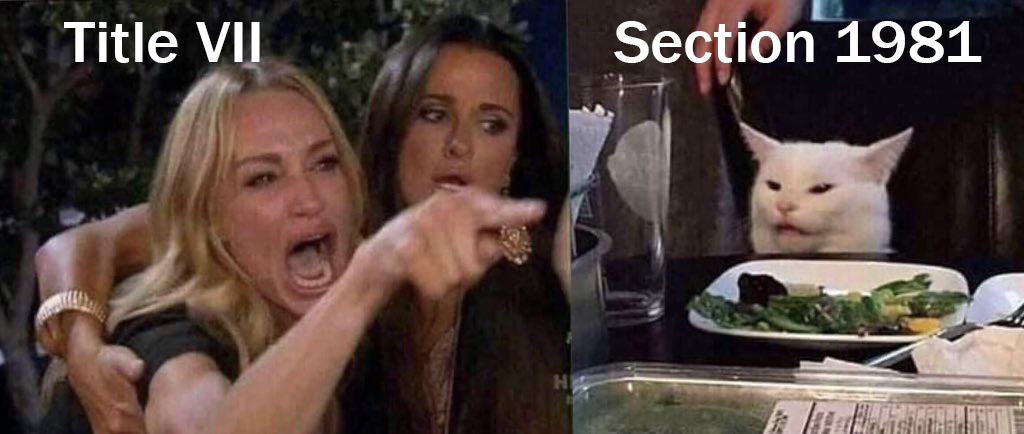You may have seen a split-screen meme circulating on social media that appears to be a woman yelling and pointing at a cat. The meme has predictably come to be known as “Woman Yelling at Cat Meme” or “Cat Meme.” The meme is a combination screenshot of a cast member of the Real Housewives of Beverly Hills—Taylor Armstrong—in a particularly emotional moment on (a 2011 episode of) the show and Smudge, a white cat (who can be found on Instagram at @smudge_lord), angrily sitting at a table in front of a plate of vegetables.
A Twitter user first used the split-screen meme, and it subsequently became a social media sensation. Oftentimes, the meme creators use “object labeling” to express differing/opposite opinions (and sometimes the same opinion in different words) to make a point. Per knowyourmeme.com, “object labeling is the practice of creating image macros in which subjects of a specific image are labeled to create a humorous interpretation of the picture.”
You may have also seen the “distracted boyfriend meme” in which a woman is walking with a man, and he turns completely around to look at another woman passing by. In one of my favorites, the distracted boyfriend is labeled “me,” the woman passing by is labeled “the solar eclipse,” and his girlfriend is labeled “scientific evidence supporting the dangers of staring at the sun.”
Applying object labeling to Cat Meme, my favorite memes are the ones in which Taylor and Smudge have expressed the same/similar opinion in different words. For example, Taylor and Smudge pronounced words as Louisianans versus the rest of the world (i.e., Taylor: “going to the grocery store” vs. Smudge: “making groceries”).
Reading these hilariously creative memes got me thinking about employment laws that are similar to and sometimes mistaken for others.
Title VII vs. Section 1981
 Most of you are probably familiar with Title VII of the Civil Rights Act of 1964 (Title VII). This federal law prohibits employment discrimination based on race (and other protected classes). However, Section 1981 of the Civil Rights Act of 1866 (Section 1981) prohibits race discrimination in employment, as well.
Most of you are probably familiar with Title VII of the Civil Rights Act of 1964 (Title VII). This federal law prohibits employment discrimination based on race (and other protected classes). However, Section 1981 of the Civil Rights Act of 1866 (Section 1981) prohibits race discrimination in employment, as well.
Although employment discrimination claims are analyzed similarly by courts, there are many differences. Section 1981 prohibits intentional discrimination only, while Title VII prohibits disparate impact, pattern and practice discrimination, harassment, and even retaliation.
Section 1981 covers more employers than Title VII; however, it does not apply to government employers in the employment discrimination context. Furthermore, Title VII covers race, national origin, religion, and color discrimination, while Section 1981 does not cover discrimination based on national origin or religion.
Section 1981 plaintiffs are not required to exhaust their administrative remedies (via the Equal Employment Opportunity Commission (EEOC) or other Fair Employment Practice Agency), while Title VII plaintiffs are. And the statutes of limitation on Section 1981 vs. Title VII claims are different, as are caps on certain types of damages.
Employers should know the differences between these two similar employment discrimination laws, and if this Title VII vs. Section 1981 meme happens to pop up while perusing social media, maybe you will chuckle.…
 Destiny Washington focuses her practice at FordHarrison’s Atlanta office on the representation of employers in labor and employment law matters. Her experience representing an international union and state and local government entities, including law enforcement agencies and school districts, gives her a unique perspective in her advice and representation. A former military print journalist, she has proudly served her country and is a veteran of the U.S. Army and the Louisiana Army National Guard. Find her on LinkedIn here.
Destiny Washington focuses her practice at FordHarrison’s Atlanta office on the representation of employers in labor and employment law matters. Her experience representing an international union and state and local government entities, including law enforcement agencies and school districts, gives her a unique perspective in her advice and representation. A former military print journalist, she has proudly served her country and is a veteran of the U.S. Army and the Louisiana Army National Guard. Find her on LinkedIn here.


